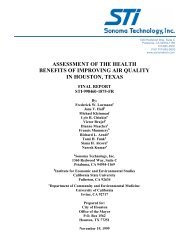A Closer Look at Air Pollution in Houston: - Green Houston
A Closer Look at Air Pollution in Houston: - Green Houston
A Closer Look at Air Pollution in Houston: - Green Houston
Create successful ePaper yourself
Turn your PDF publications into a flip-book with our unique Google optimized e-Paper software.
Appendix 4Metals, Diesel PM Conversions and Polycyclic Organic M<strong>at</strong>terAll Metals AnalysesThe U.S. EPA's 1999 N<strong>at</strong>ional <strong>Air</strong> Toxics Assessment(NATA) (U.S. EPA, 2006b) model<strong>in</strong>g and analyses used f<strong>in</strong>e andcourse PM d<strong>at</strong>a <strong>in</strong> model<strong>in</strong>g metal concentr<strong>at</strong>ions. The Mayor'sTask Force analyses used only f<strong>in</strong>e PM metal concentr<strong>at</strong>ionsfrom PM 2.5 speci<strong>at</strong>ed metals d<strong>at</strong>a files from the U.S. EPA's <strong>Air</strong>Quality System d<strong>at</strong>abase (U.S. EPA, 2006e) to compare to referenceconcentr<strong>at</strong>ions (RfCs) and unit risk estim<strong>at</strong>es (UREs).The choice to elim<strong>in</strong><strong>at</strong>e the PM 10 speci<strong>at</strong>ed metals d<strong>at</strong>a wasbased on the assumption th<strong>at</strong> PM 2.5 particles would penetr<strong>at</strong>efurther <strong>in</strong>to the lungs and therefore represent gre<strong>at</strong>er healthconsequences than PM 10 speci<strong>at</strong>ed metals. After complet<strong>in</strong>gthe analyses, it was found th<strong>at</strong> metal concentr<strong>at</strong>ions from ambientPM 2.5 speci<strong>at</strong>ed metals files for 2004 were consistentlylower than the modeled NATA concentr<strong>at</strong>ions from 1999. The<strong>in</strong>consistency between the modeled and ambient d<strong>at</strong>a analysesis further complic<strong>at</strong>ed by the fact th<strong>at</strong> the time frame forthese analyses is separ<strong>at</strong>ed by five years. The NATA Model-to-Monitor Comparison (U.S. EPA, 2006g) reported th<strong>at</strong> measuredambient metal concentr<strong>at</strong>ions were typically higher than modeledconcentr<strong>at</strong>ions for chromium, lead, manganese and nickel.Recalcul<strong>at</strong><strong>in</strong>g our ambient metal concentr<strong>at</strong>ions to <strong>in</strong>cludeboth f<strong>in</strong>e and course speci<strong>at</strong>ed metals may lead to higher riskc<strong>at</strong>egories reported for metals from ambient d<strong>at</strong>asets.Chromium CompoundsChromium compounds, which are a group of pollutants, are listed<strong>in</strong> the Clean <strong>Air</strong> Act (U.S. EPA, 1990) as one of the 188Hazardous <strong>Air</strong> Pollutants (HAPs). Chromium sources of emissions<strong>in</strong>clude the combustion of coal and oil, electropl<strong>at</strong><strong>in</strong>g,vehicles, iron and steel plants, and metal smelters. Chromiumoccurs <strong>in</strong> the environment primarily <strong>in</strong> two valence st<strong>at</strong>es, trivalentchromium (Cr III), which occurs n<strong>at</strong>urally and is an essentialnutrient, and hexavalent chromium (Cr VI), which along withthe less common metallic chromium (Cr 0), is most commonlyproduced by <strong>in</strong>dustrial processes. <strong>Air</strong> emissions of chromiumare predom<strong>in</strong>antly of trivalent chromium, and <strong>in</strong> the form ofsmall particles or aerosols. Chromium forms a large number ofcompounds, <strong>in</strong> both the chromium (III) and chromium (VI) forms(ATSDR, 1998). The Mayor's Task Force assessed chromium(VI) compounds as a group of pollutants us<strong>in</strong>g modeled concentr<strong>at</strong>ionsfrom the U.S. Environmental Protection Agency's1999 N<strong>at</strong>ional <strong>Air</strong> Toxics Assessment (U.S. EPA, 2006d).Modeled chromium VI compound concentr<strong>at</strong>ions wereassessed for carc<strong>in</strong>ogenic and non-carc<strong>in</strong>ogenic endpo<strong>in</strong>ts.Currently, no UREs or RfCs exist from the sources consulted forchromium III compounds, and chromium III is much less toxicthan chromium VI.The emissions of chromium compounds reflected <strong>in</strong> the1999 NATA assessment are based on st<strong>at</strong>e and local agencyreport<strong>in</strong>g of chromium as "chromium and compounds," <strong>in</strong>dividualchromium compounds and chromium ions. In the EPA's1996 N<strong>at</strong>ional <strong>Air</strong> Toxics Assessment (U.S. EPA, 1999),because of the <strong>in</strong>consistent report<strong>in</strong>g, all of the chromium waslumped together for dispersion model<strong>in</strong>g as "Chromium VI."EPA then based quantit<strong>at</strong>ive risk estim<strong>at</strong>es on an assumptionth<strong>at</strong> 34 percent of the chromium is hexavalent chromium basedon <strong>in</strong>form<strong>at</strong>ion from past <strong>in</strong>ventory<strong>in</strong>g efforts. For 1999, EPAused a more ref<strong>in</strong>ed approach to estim<strong>at</strong>e emissions of hexavalentchromium. Individual compounds of chromium reported <strong>in</strong>the <strong>in</strong>ventory were identified as either hexavalent or trivalentbased upon their chemical formulae. Any compounds reportedas either "chromium" or "chromium and compounds" were thenspeci<strong>at</strong>ed us<strong>in</strong>g source c<strong>at</strong>egory specific speci<strong>at</strong>ion d<strong>at</strong>a (U.S.EPA, 2004). For source c<strong>at</strong>egories where speci<strong>at</strong>ion d<strong>at</strong>a werenot available, EPA assumed th<strong>at</strong> 34 percent of the chromium ishexavalent.Elemental Carbon to Diesel PM Conversion FactorIn order to assess diesel particul<strong>at</strong>e m<strong>at</strong>ter concentr<strong>at</strong>ionsthe Task Force used ambient elemental carbon (EC) concentr<strong>at</strong>ionsfor 2004 (U.S. EPA, 2006f) as a surrog<strong>at</strong>e for diesel particul<strong>at</strong>em<strong>at</strong>ter (PM) concentr<strong>at</strong>ions. This technique used the rel<strong>at</strong>ivecontribution of diesel combustion to all sources of ambientEC to determ<strong>in</strong>e a scal<strong>in</strong>g factor for diesel PM concentr<strong>at</strong>ions.Sources of EC <strong>in</strong> the <strong>Houston</strong> area <strong>in</strong>clude gas anddiesel vehicles, road dust, veget<strong>at</strong>ive detritus, wood combustion,me<strong>at</strong> cook<strong>in</strong>g and fuel oil combustion. A study by Fraser,41







